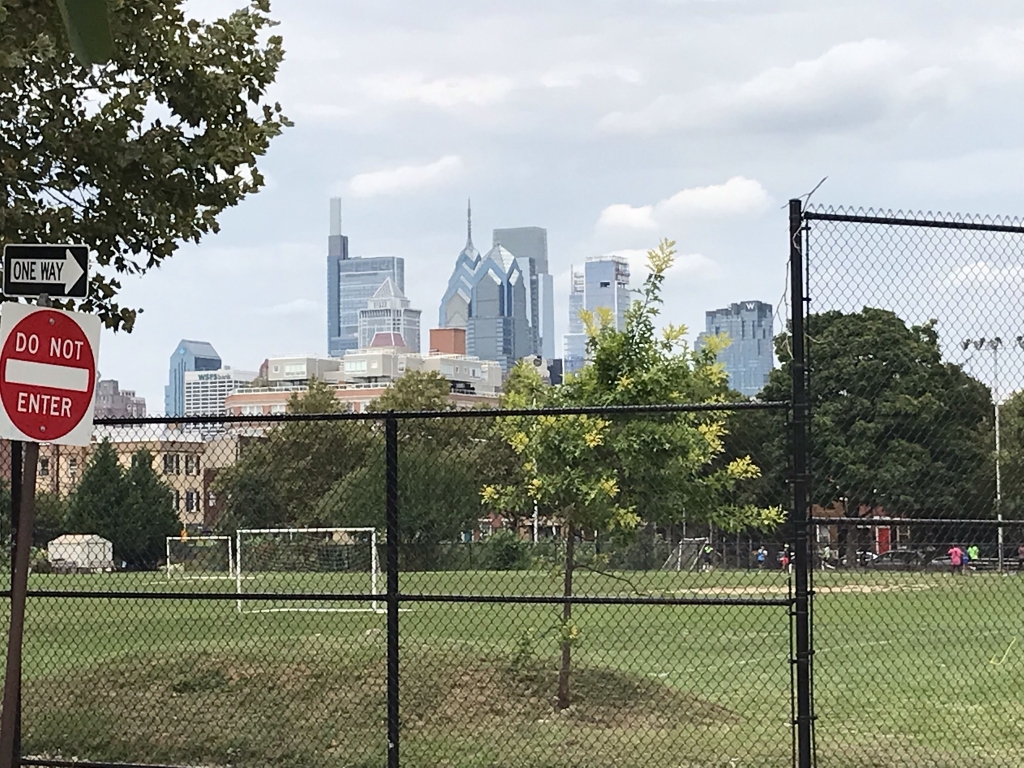For some reason I'd never been to Philadelphia before the weekend of this trip. One would think I would have during all those years living in New Jersey in the early 2000s, but the closest I ever got was a visit to the museum ship USS New Jersey across the river in Camden, NJ. Of course I was still living with my parents then so any trips I went on back then were all their ideas. So of course, when thinking of weekend trips I could take during my temporary stay in Maryland, Philly was one of the first places that came to mind, and that's where I spent the weekend of August 14-15, 2021.
Naturally, I just had to ride a train to Philadelphia. During those two glorious years in Germany I had gotten used to using trains to easily get around from one city to another, and "Boswash"--the conurbation stretching from BOSton to WASHington--is the region of the US where it is easiest to do that as well. Amtrak has no less than eight routes going up and down its Northeast Corridor multiple times every day, not to mention all the commuter rail services like MARC one finds in the various metro areas along the corridor. That's not too different from Stuttgart, Germany, where I last lived, and quite a far cry from my old home city San Antonio which only sees one train roll through thrice a week in each direction, usually at ungodly, inconvenient hours.
This would be my first time riding any of Amtrak's Northeast Corridor trains, having previously only ridden two long-haul trains in the west, the Coast Starlight from Burbank to Paso Robles, CA and the Texas Eagle from Dallas to San Antonio, TX. That last one had left me particularly disgruntled because it had been two hours late, since it had to stop and wait in Austin after a freight train had broken down on the tracks, and after that train had been moved out of the way, the one I was on couldn't get going until all the other freight trains that had been blocked went first, because freight trains always have priority on their own tracks.
Nothing like that happened on this trip! On the Northeast Corridor, Amtrak owns all the trackage, so there's no getting blocked by freight trains. And, get this, I actually arrived at my destination ten minutes early! I started from the BWI station, that is, the rail hub that's right next to Baltimore-Washington airport, and my train, the Northeast Regional was scheduled to get me to Philadelphia 30th Street Station in an hour and 30 minutes. It only took an hour and 20. I was really impressed. Amtrak service in the northeast is, I think, almost on the same level as any western European rail company. Not quite as good but almost. There was a café car where I bought a cup of coffee (and that was my only complaint, it took forever because there was only one person behind the counter taking a frustratingly long time making people's food orders), and all around the experience just felt not very different from any of the non-high-speed IC or EC trains I rode in Germany or Belgium or anywhere else I visited back then.
Also the train was sold out with every seat taken. That may have been slightly annoying but I liked that, because it tells me that people in this part of the country actually ride the trains. That's especially encouraging after the pandemic temporarily scared everyone away.

The massive hall inside 30th Street Station, after I debarked from the train and went up the stairs. Impressive!
Before leaving the station, I had to buy myself a pass for public transit. I was able to buy a fare card from a machine in the station. This card was a "smart" card with a chip in it, not unlike my credit cards. I've still got it, I'm using it as a bookmark for the moment and if I ever go back to Philadelphia I can easily recharge it and use it again.
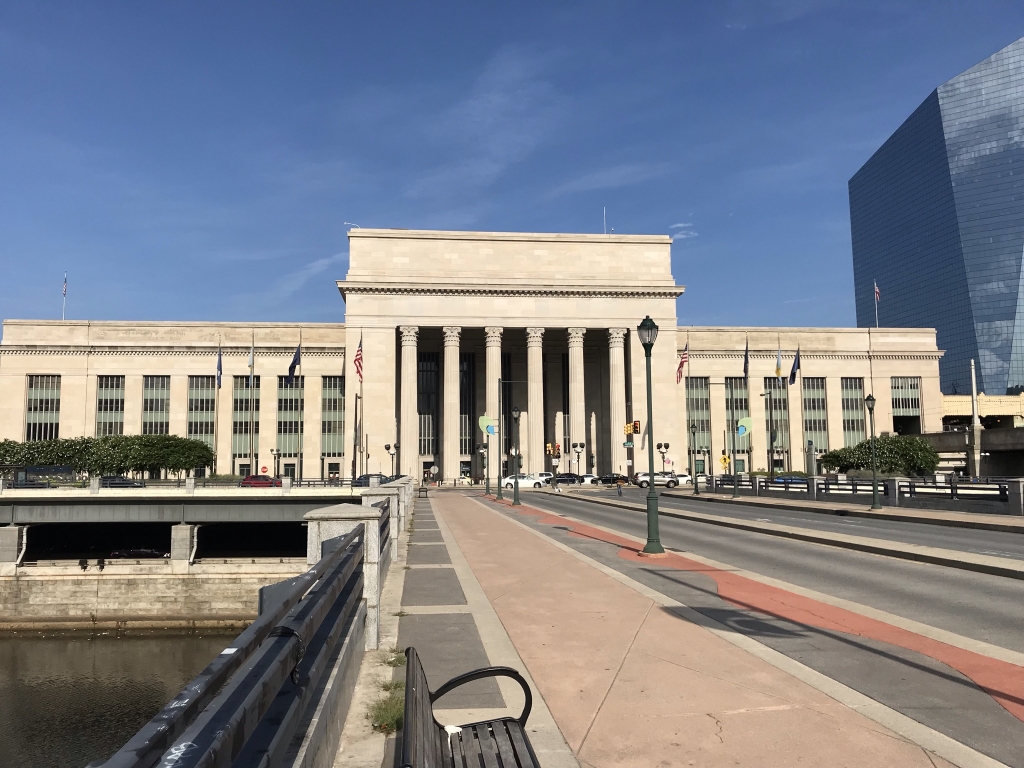
30th Street Station from the outside. I'd never been to Philadelphia but this still looked familiar. I used to see it all the time in the opening credits of It's Always Sunny in Philadelphia.
I slowly walked from the station along John F. Kennedy Blvd. in the direction of downtown. The weather that day was HOT. But I didn't want to get on the subway just yet, though, because I hadn't seen anything in this city in person yet. As I walked east, I saw a few things of interest.
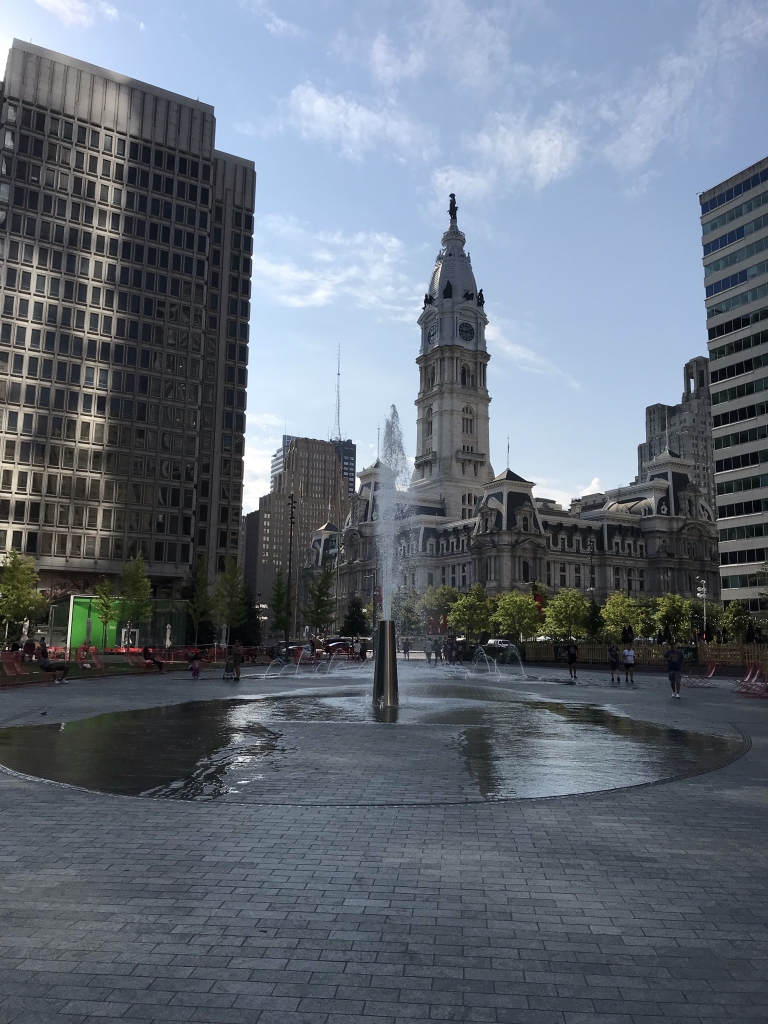
Behind the fountain you can see Philadelphia City Hall. Construction lasted from 1871 to 1901, and it was briefly the tallest building in the world from 1894 to 1908.
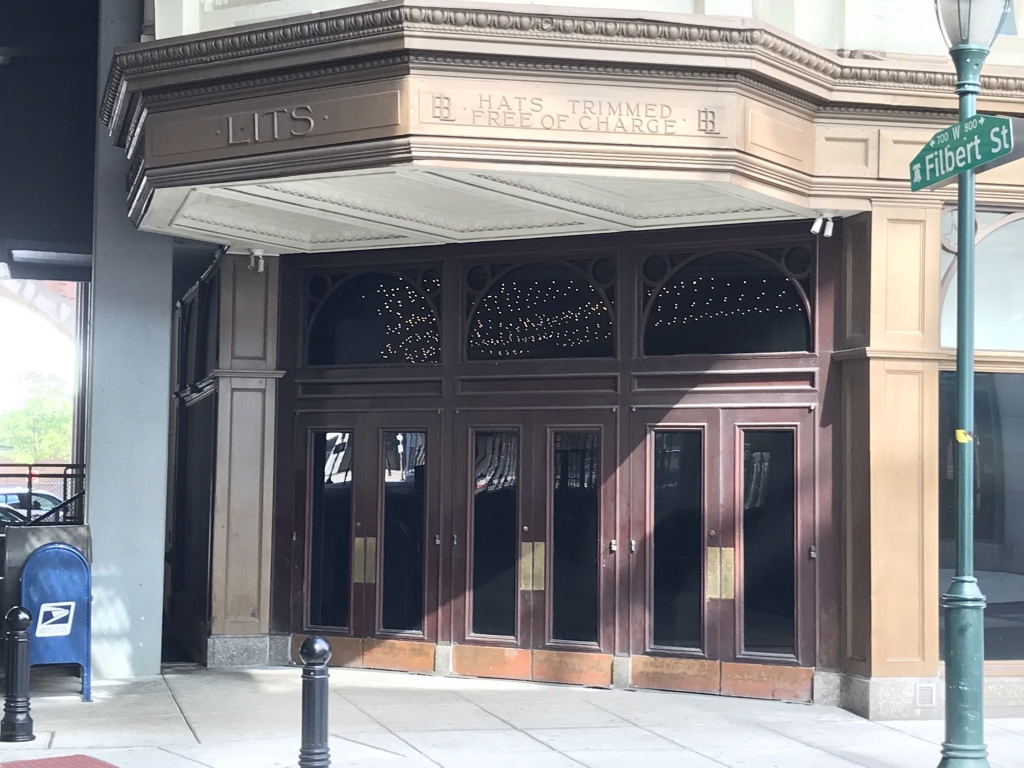
Not far from Reading Terminal Market, which I briefly walked through, is this. The building is still in use, with the first floor being occupied by various stores like Five Below. Lits seems to be long gone, so I doubt you can get your hat trimmed for free here anymore.
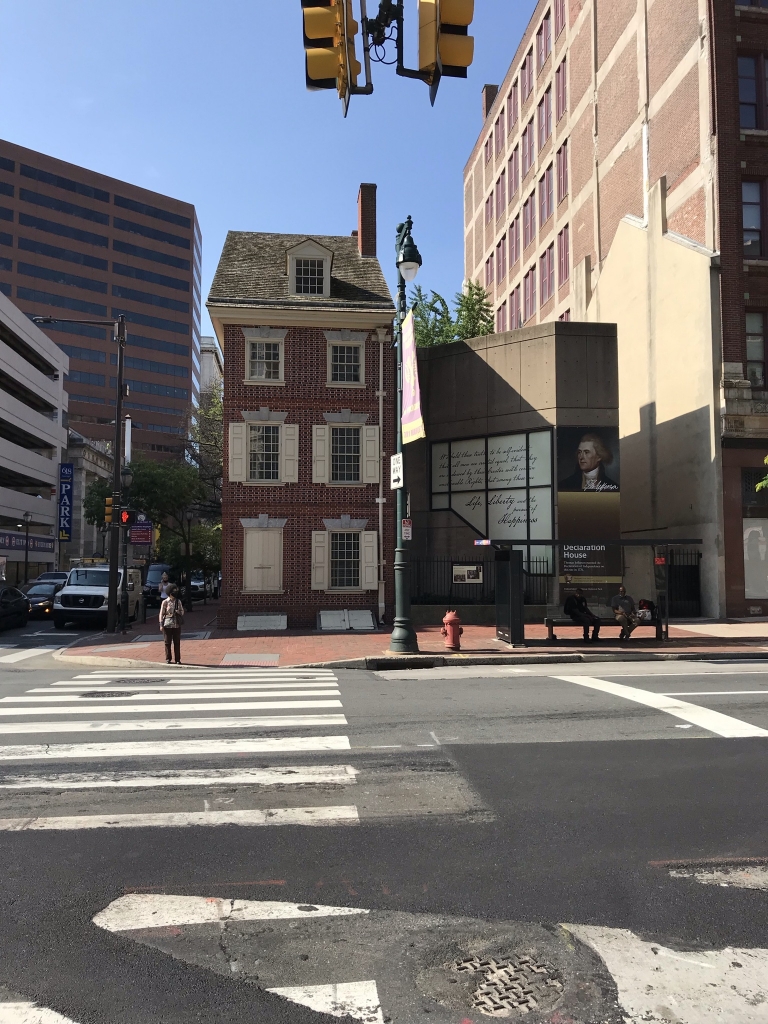
This appears to be the house in which Thomas Jefferson penned the Declaration of Independence. Turns out it's a replica. The original was torn down in 1883; what you see here was put up in 1976 as part of the USA Bicentennial celebrations.
I stopped at something that really stood out, what seemed to be the remnants of a building. Only a few disparate pillars and brick walls remained of what used to be the President's House, the mansion where George Washington and John Adams lived during their administrations when Philadelphia was the temporary capital city of the United States.
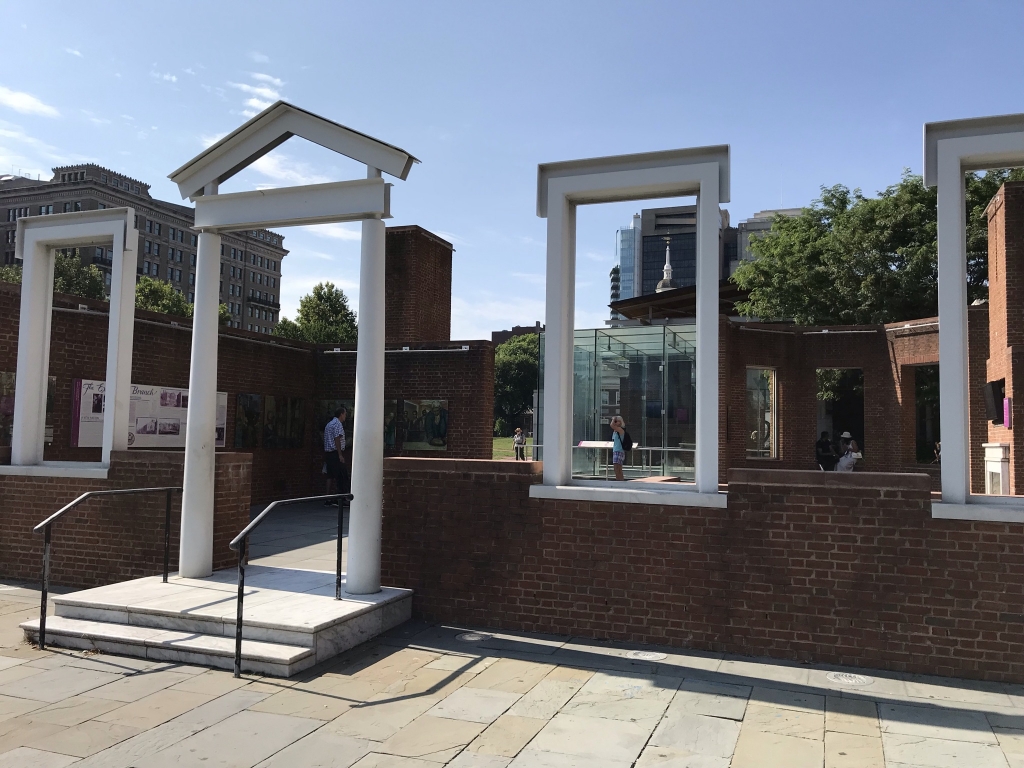
When the Constitution went into effect, the nation's capital was New York City, which is where President Washington lived during the first year-and-a-half of his administration. After that the capital, and the president, moved to Philadelphia, where it stayed until 1801 when Washington, DC became the permanent capital.
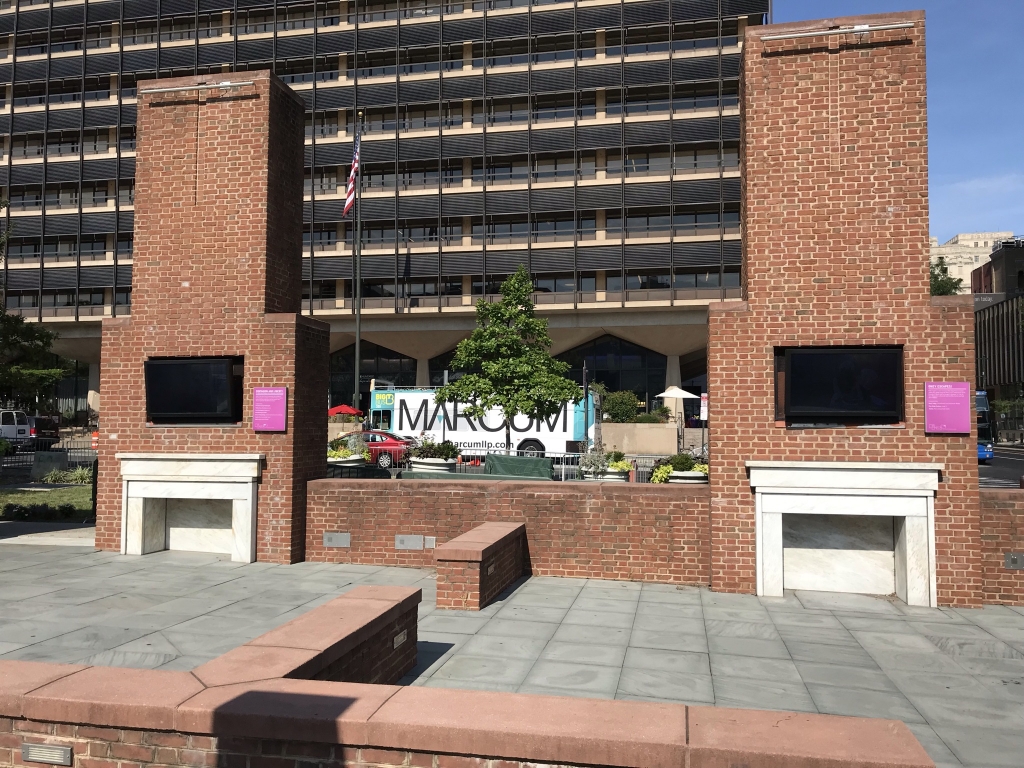
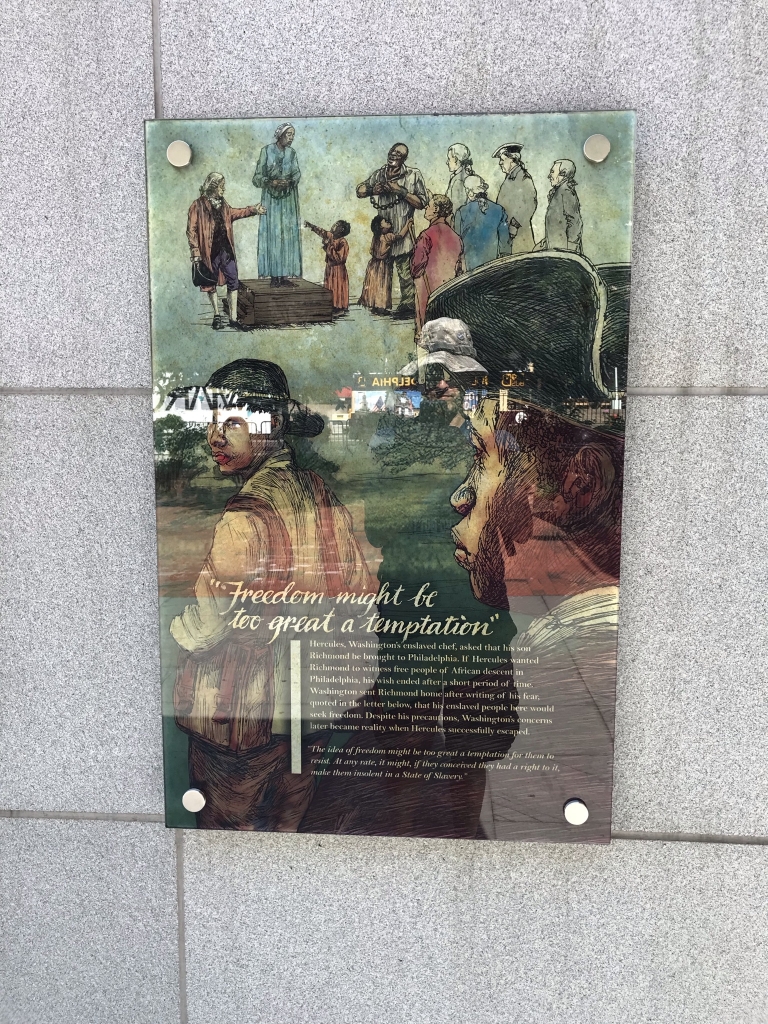
There was a lot to learn here. As I hope we all already knew, George Washington was a slaveowner, and he brought some of his human property to Philadelphia to be servants in the mansion. At that time the state of Pennsylvania was gradually abolishing slavery. Washington's enslaved head chef, Hercules, asked him to bring his son Richmond up from Mount Vernon to join them in Philadelphia. Washington sent Richmond home after only a short time, because he was afraid Richmond would witness the free black community living there and want to be free himself. Hercules eventually escaped himself in 1797.
Kind of reminds me of North Korea and how they only let people work outside the country if the authorities believe they're sufficiently loyal and not likely to defect. It's almost like they're afraid of their people seeing what life is like outside their borders.
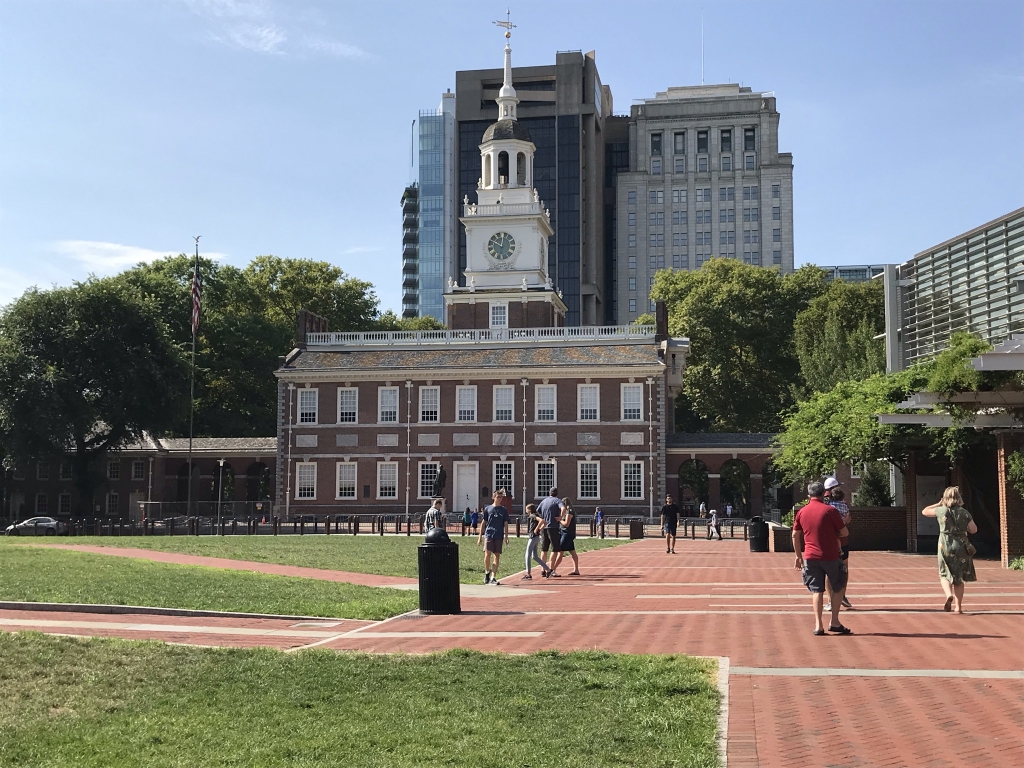
This is the building we all know as Independence Hall, where the Declaration of Independence and Constitution were both debated, drafted, and signed. Originally the Pennsylvania State House, it was the seat of the Pennsylvania legislature as well as the Second Continental Congress. Back in those early days, there was a bell in the steeple that rang to summon members to the assembly hall; that bell is what we now know as the Liberty Bell.
The Liberty Bell is on display in a building next to the remains of the President's House, known as the Liberty Bell Center. They were only letting a limited number of people in the building at one time, probably due to social distancing requirements, so I had to wait in line to get in.
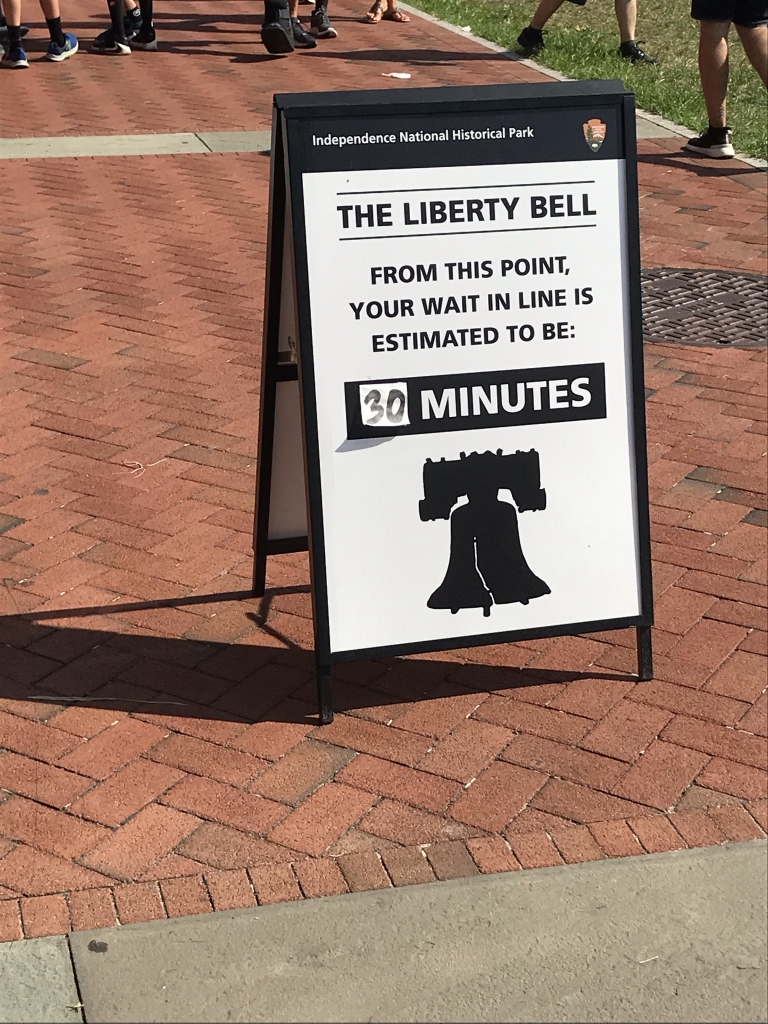
Oh dear...did I mention it was hot out?
Inside the building is a small museum with a lot of historical information about the bell and its use as a symbol of liberty. How did it get cracked? It seems that there had once been a smaller crack, repair workers had filled it in, and then when ringing for a celebration of George Washington's birthday in 1846, the crack reappeared and got bigger. Now we'll never know what it sounded like.
The Liberty Bell throughout the 1800s was a widely recognized symbol of freedom and its image adorned abolitionist newspapers and suffragette publications. It was carried on long tours around the nation, and wherever it went, thousands gathered to see it like it was a sacred relic.
Many replicas of the bell were made and proliferated. One of these was the Women's Liberty Bell, which was made in support of a Pennsylvania referendum on a proposed state constitution amendment in 1915 which would legalize women's voting rights. This bell had chains wrapped around its clapper, silencing it, symbolizing how women had no voice without a vote. The bell toured all of the state's counties but the referendum ultimately failed. Of course, that was rendered moot, and the suffragettes ultimately won the day, five years later when the 19th Amendment passed.
So the original Liberty Bell is in this building. And after going through all these displays, you finally get to see it...
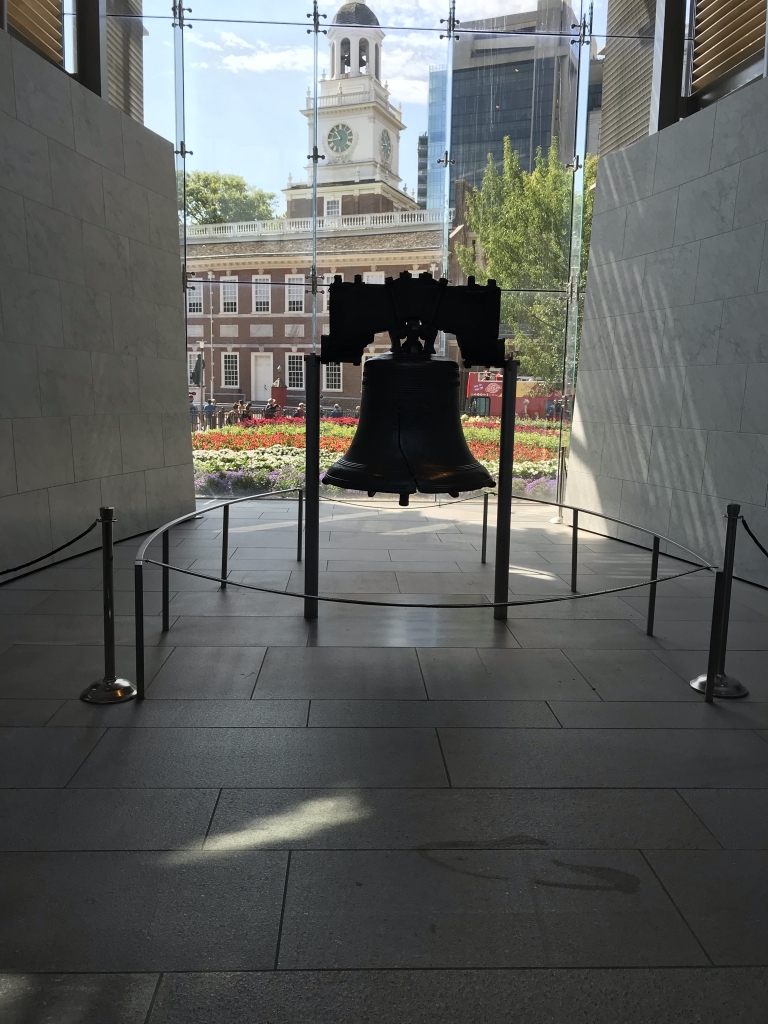
Like I previously mentioned, replicas of the Liberty Bell have widely proliferated over the last two centuries, and on later trips during my stay in Maryland I unintentionally encountered two of them. Take a look...
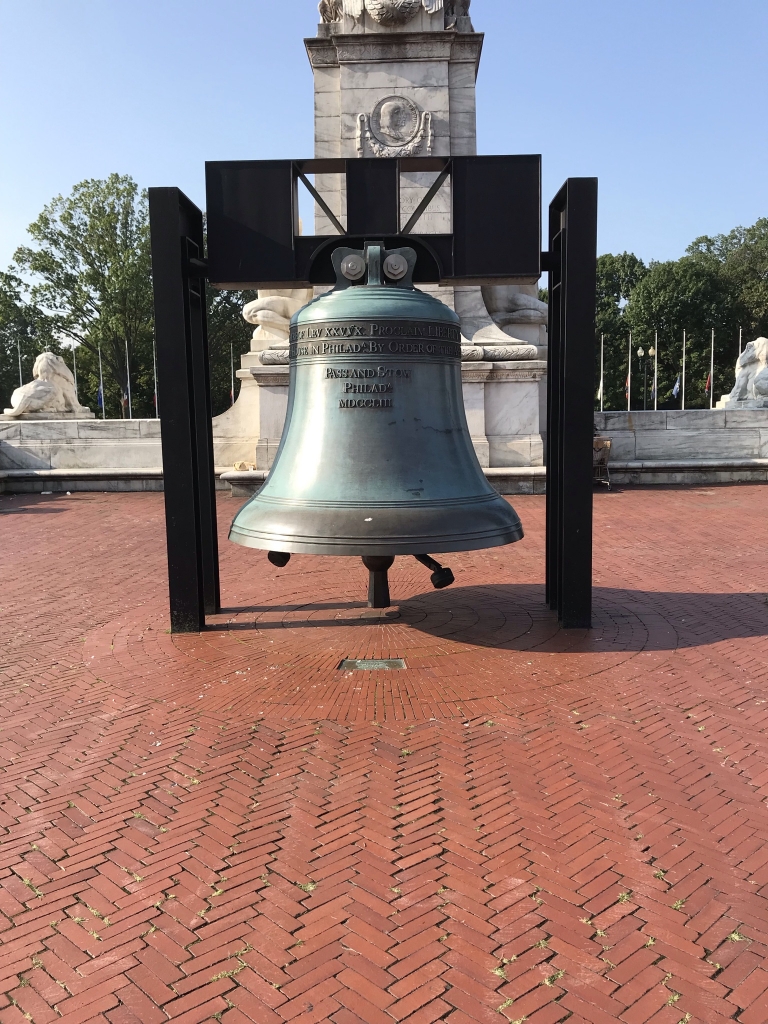
This Liberty Bell replica is the first thing you see when you step outside of Union Station in Washington, DC, two weeks after the Philadelphia trip.

This one is on the Delaware state capitol grounds in Dover, Delaware. I spotted this while driving through Dover on September 11, 2021, four weeks after seeing the real one.
My next stop after the Liberty Bell was Christ Church Cemetery. This is the final resting place of a great many important figures in US history, most famously Benjamin Franklin. At the entrance there's a kiosk selling various souvenirs and such. I bought two things there. First, I found a pint glass bearing one of Benjamin Franklin's more famous quotes, "Beer is living proof that God loves us and wants us to be happy." I absolutely had to buy that, although when I first used it a month later I found it was cheaply made and the lettering peeled off too easily. The other thing I bought was a thick biography, Benjamin Franklin: An American Life by Walter Isaacson. At the time I'm writing this I'm about a third through that book and have really enjoyed it so far.
Inside the cemetery, the headstones are so old, dating from the 1700s and early 1800s, that they're badly eroded which makes the engravings nearly impossible to read. There are informational plaques near some of the more important people's graves so that you know who is buried there. You can find the graves of Charles Mason (a British astronomer and surveyor who, with Jeremiah Dixon laid down the border between Pennsylvania and Maryland that became known as the Mason-Dixon Line), Benjamin Rush (a physician and psychiatrist who was among the signers of the Declaration of Independence), Commodore William Bainbridge (a naval officer who served in the Barbary Wars and in the War of 1812, during the latter of which he commanded the USS Constitution), and, finally...
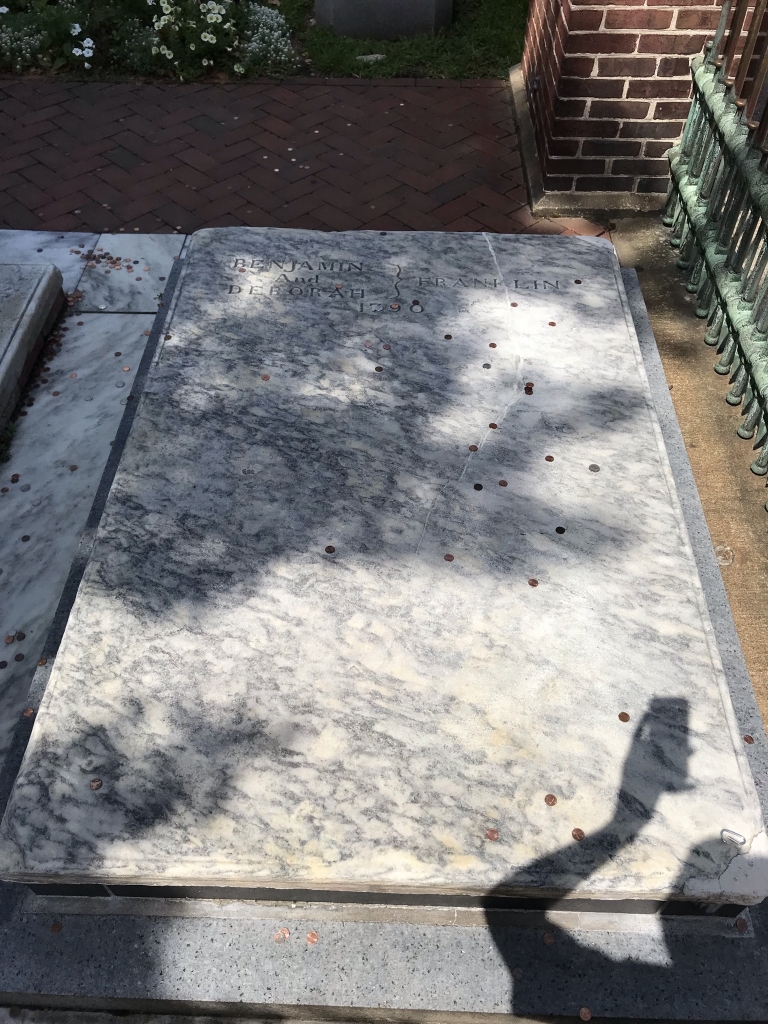
Ben Franklin himself is buried here, with his wife Deborah. Quite a simple grave. As I've found from the aforementioned biography I've been reading, Franklin usually rejected the fancy in favor of the practical.
As I've read more about Franklin from his biography, I've seen that the way I've been trying to live the past decade or so--not spending too much money on things I don't need, using what I have until it's completely worn out and unserviceable--isn't too far off from his own pragmatic philosophy of life. I like to think that if Franklin could see today, he'd be at least a little impressed by how I live. I know he'd share my disdain for how wasteful our society is, how other people are always throwing perfectly good gadgets, clothing, and furniture in the trash every day. But this is a topic for another blog.
Now it was about time for lunch, and I really wanted to try Philadelphia's most famous local dish: the cheesesteak! I took a subway train to South Philly where I knew where the original authentic restaurants were. Wikitravel said that there's two restaurants, right across a street corner from each other, that both claim to be the originator of the cheesesteak: Geno's and Pat's. I could only have one and it didn't make much difference to me which one I'd pick, so I just went with Geno's because it was the first one I saw.
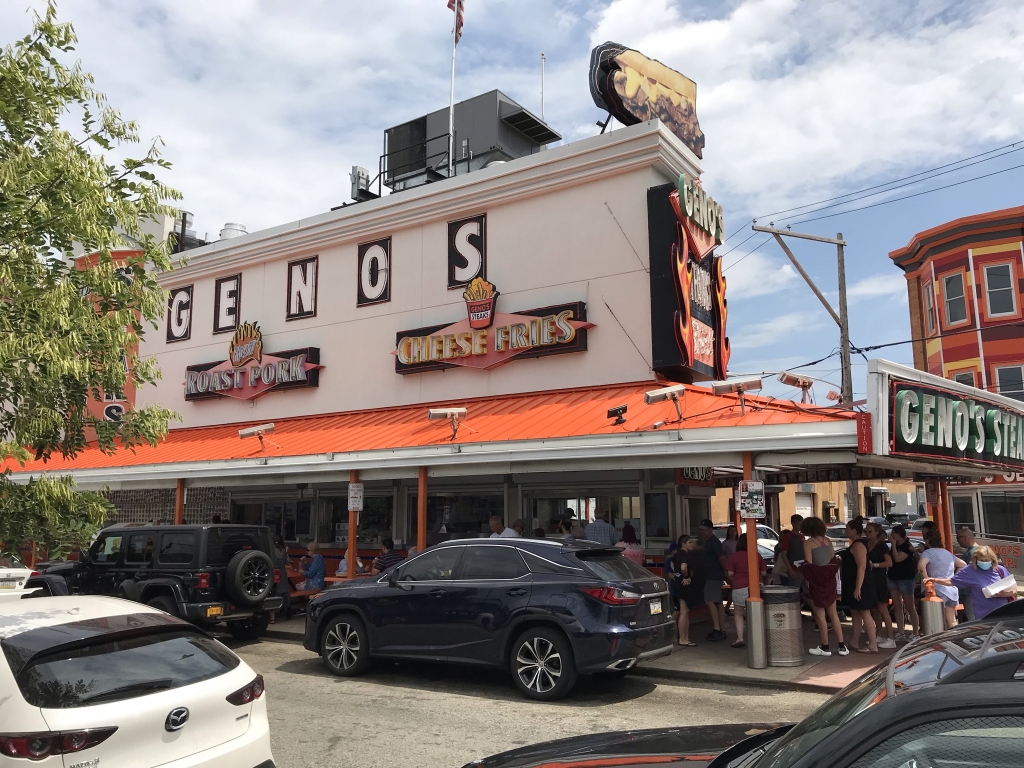
This place was pretty popular. All the outdoor tables were taken so I had to eat on a bench across the street.
I got the most authentic cheesesteak I could. It was about a foot long, full of hot sliced beef and onions. There were a few different cheeses I could've gotten, but had the cheese that I'd heard the most authentic cheesesteaks had: "Whiz." Yes, Cheez Whiz, that processed cheese spread that you can buy in a squeezable bottle. After waiting a couple minutes after ordering I claimed my cheesesteak and sat on a bench across the street, under the blazing hot sun, to enjoy this greasy, tasty monstrosity.
A foot-long cheesesteak may not be the healthiest thing in the world but it was delicious. I even think I might buy some Whiz later for my own sandwiches, even though I'm usually the type who enjoys imported hard cheese blocks that you can only find in organic stores.
Because it was so hot out, I stopped at a nearby CVS and got a cold bottle of water, and then slowly made my way northeast toward the city center on Passyunk Avenue. This is a street I wish I'd spent more time on, one of those trendy streets lined with restaurants, cafés, bars, and various shops.
At one point on this long walk in the hot sun I happened upon an Irish pub. I always have to stop by an Irish pub in every city I visit, and I needed a rest after all this hiking in the intense heat, so I went in. The place was called Paddy Whacks. First I had a coffee (not Irish, just plain coffee). It took a little while to get this coffee though, because this particular bartender kept getting distracted talking with other guests while getting the coffee, and after that getting the sweetener and the half-and-half. Still a great place, though! The coffee was a nice injection of caffeine, then I thought it wasn't too early for beer so I had a pint of Guinness. And after that, I wasn't too eager to walk out into the blazing sun so soon so I had another pint of Guinness.
As relaxing as it would've been, I couldn't just stay in the pub and drink the day away. After the second pint I paid my tab and stepped back out into the heat. The waterfront was close by so I made my way there.
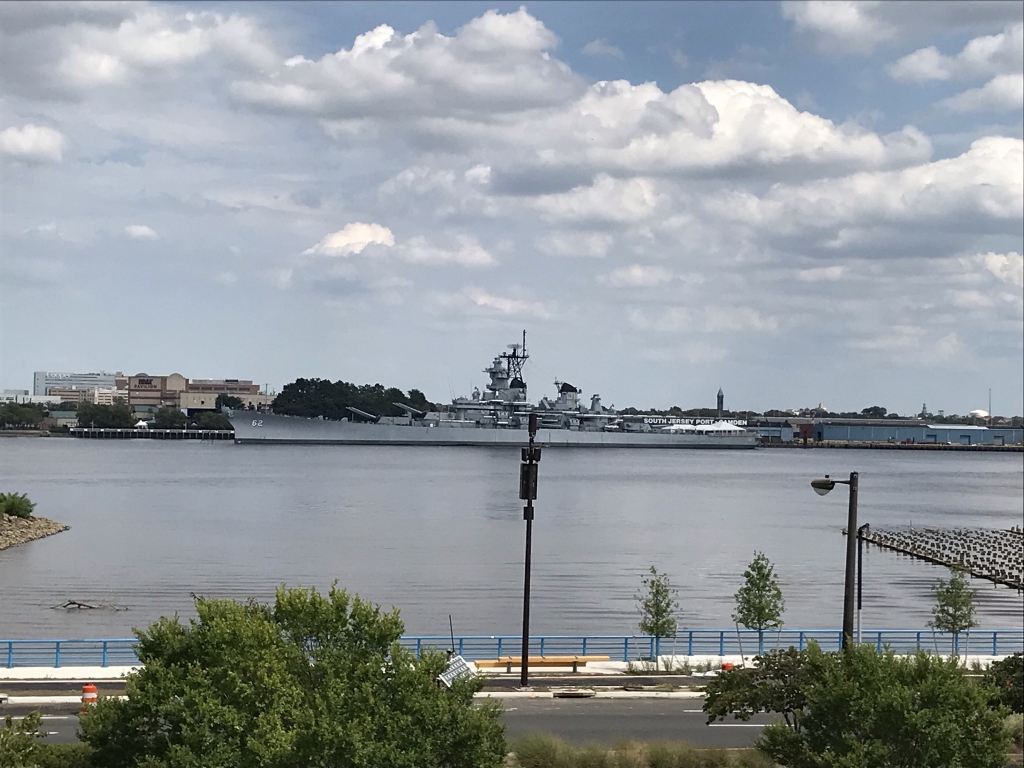
The battleship USS New Jersey docked across the Delaware River in Camden, New Jersey. Before this trip, a tour of this museum ship almost 20 years earlier was the closest I ever got to Philadelphia. Much more recently I got to walk through New Jersey's sistership, the Missouri which is docked at Pearl Harbor, Hawaii.
Walking north along the waterfront I found an unexpected surprise:
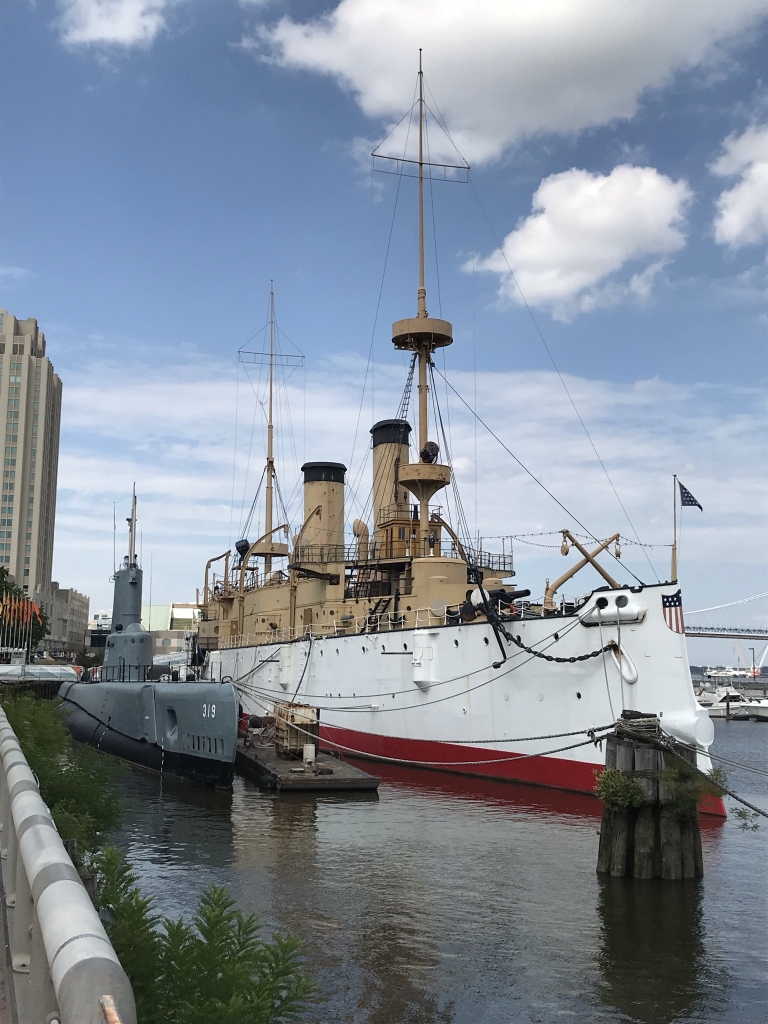
This is the cruiser USS Olympia, a generation older than the New Jersey. She was in service from 1895 to 1922 and saw service in the Spanish-American War and World War I. Next to it is a WWII-era submarine, the USS Becuna.
I've been through a lot of museum ships, mostly WWII-era ships and a few older sailing ships. Just a week earlier I had been in Baltimore touring the mid-1800s sailing ship USS Constellation and the WWII-era submarine USS Torsk. But something of this vintage, a coal-fired steam-powered vessel from the turn-of-the-last-century, I'd never seen with my own eyes and had long wanted to walk through. So of course I absolutely had to see this one. There's something about that era that really fascinates me, probably because it's so long ago that no one from then is still alive, but recent enough that you can actually observe it through photographs and not just paintings.
Olympia served in the Spanish-American War at the tail end of the 1800s. I'm not too familiar with the details of that war, but the American Commodore Dewey used Olympia as his flagship during the Battle of Manila Bay in 1898. After the war was over, she was relegated to being a training ship for new sailors, but was pressed back into active service in 1916 when the US entered the first World War. Her final mission before retirement was exactly a century ago, in 1921, to bring the remains of America's Unknown Soldier home from France.
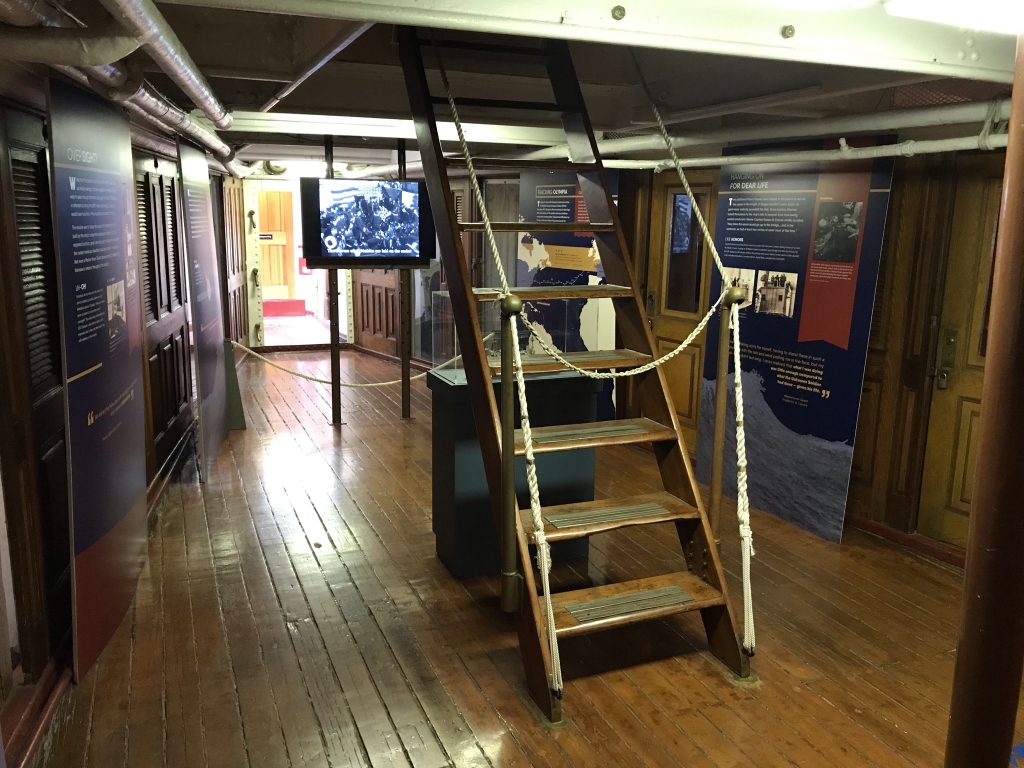
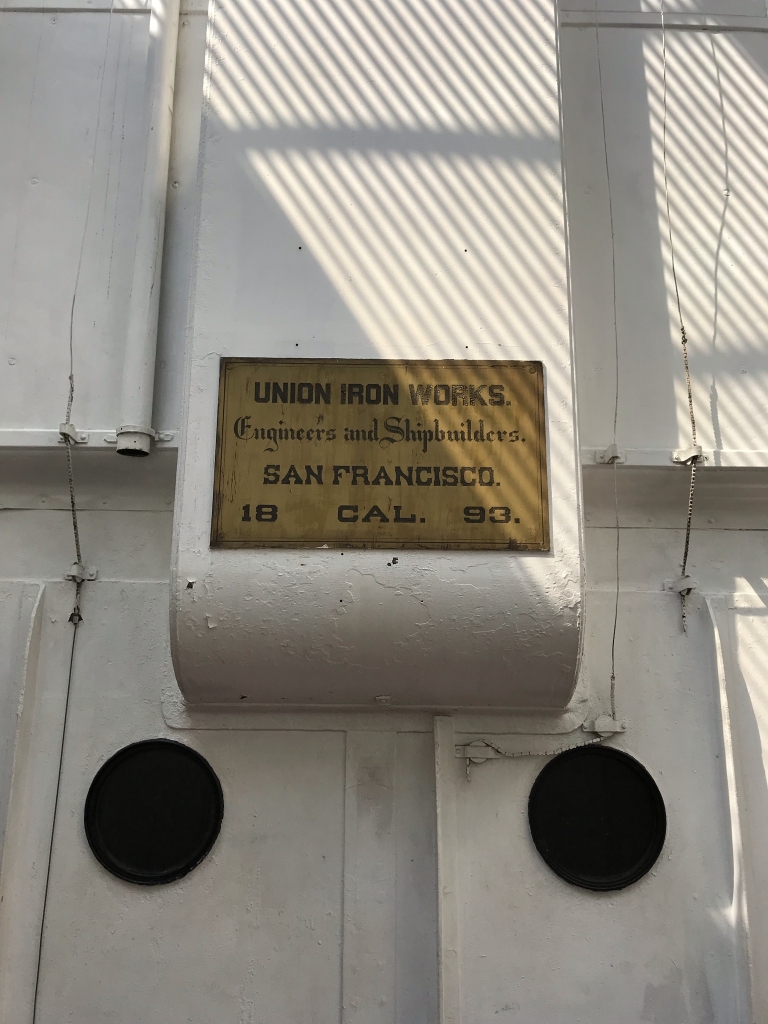
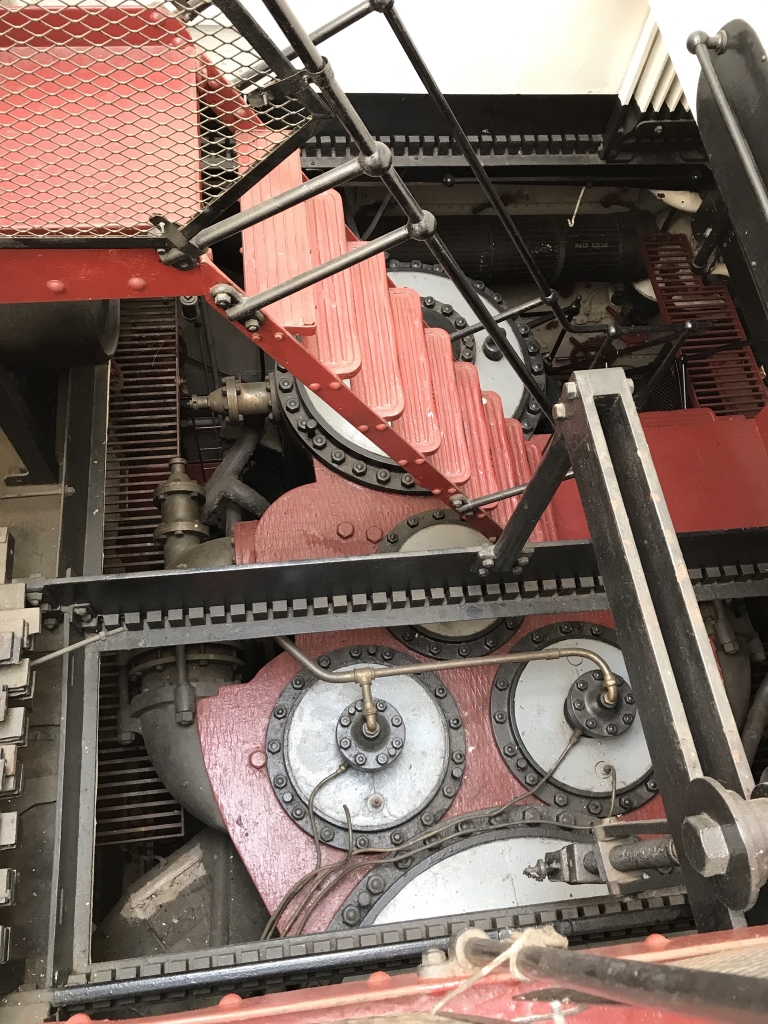
The engine room lies at the bottom of this stairway, and was off limits to visitors. All the enlisted men on the ship, not just the engineers, had to spend a shift shoveling coal into the boilers. Everyone hated having to do this, because it was filthy, grueling work, and it was doubtless murder on the lungs. A nearby informational sign explained that Olympia could go 5,900 nautical miles on one tank of coal, and that the Navy once had a fleet of coaling ships around the world but eventually replaced this with a network of coaling outposts spread out over the globe.
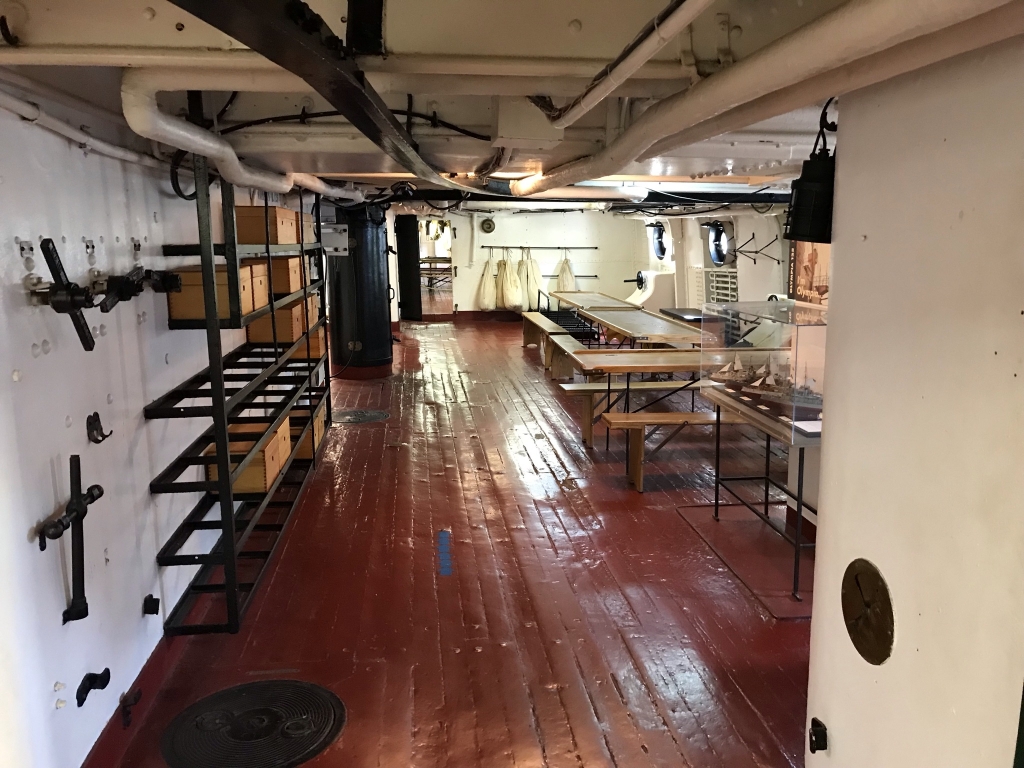
The ship's galley.
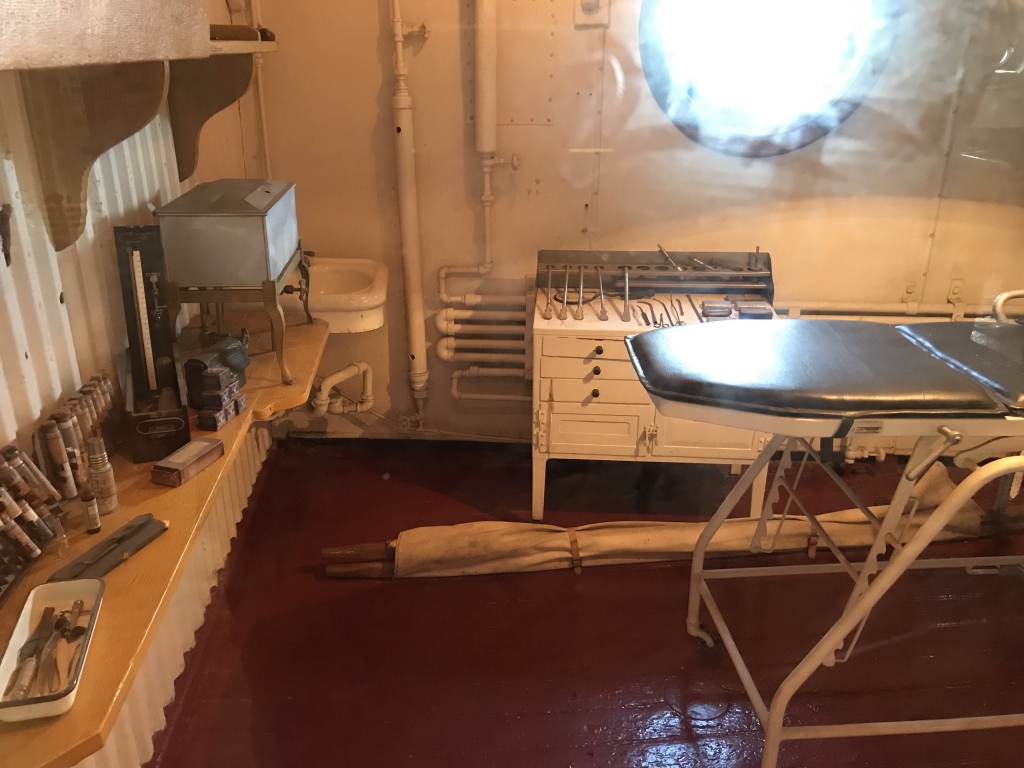
This apparently was the sickbay.
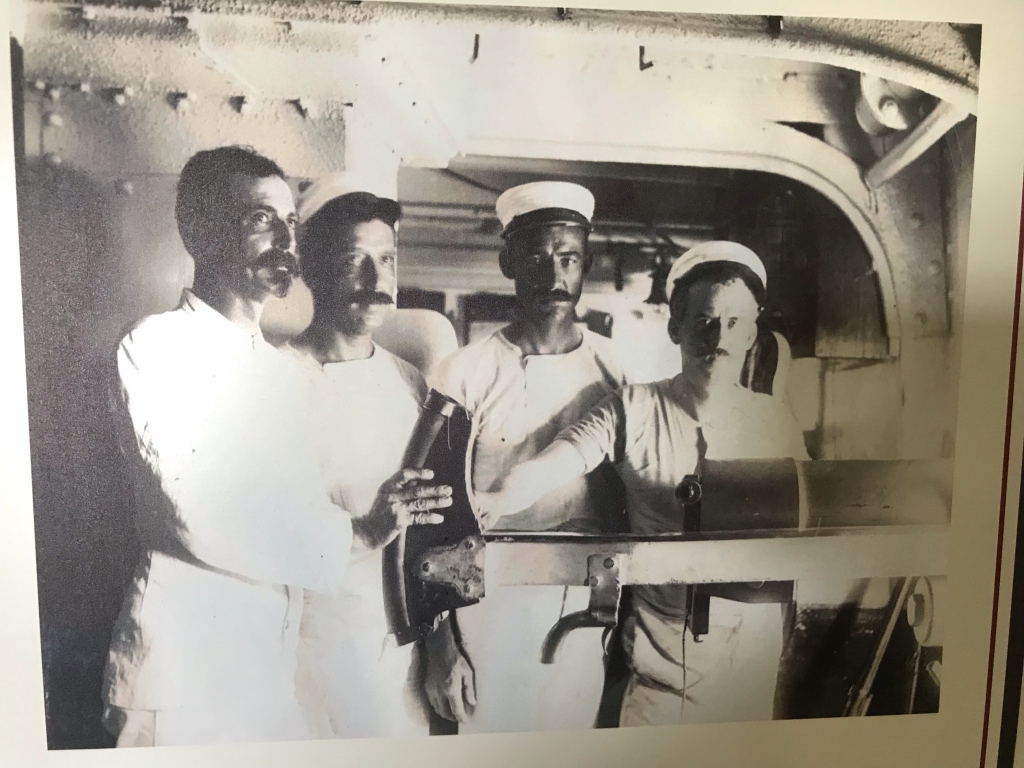
In case you'd forgotten what era this ship was part of. Those are some amazing 'staches.
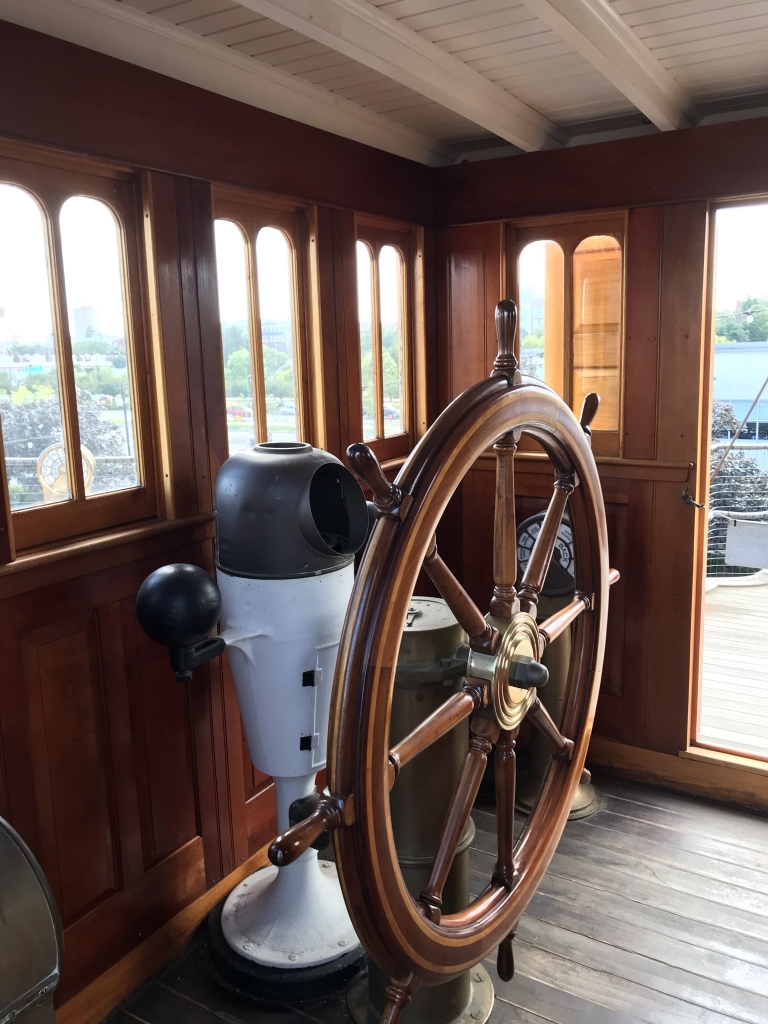
Finally, up on top, here's the helm.
Right next to Olympia was a WWII-era submarine, USS Becuna. This one was a guided tour, unlike Olympia which you can just walk through yourself. A week before this, I got to walk through another WWII submarine, the USS Torsk, and this one was quite similar.
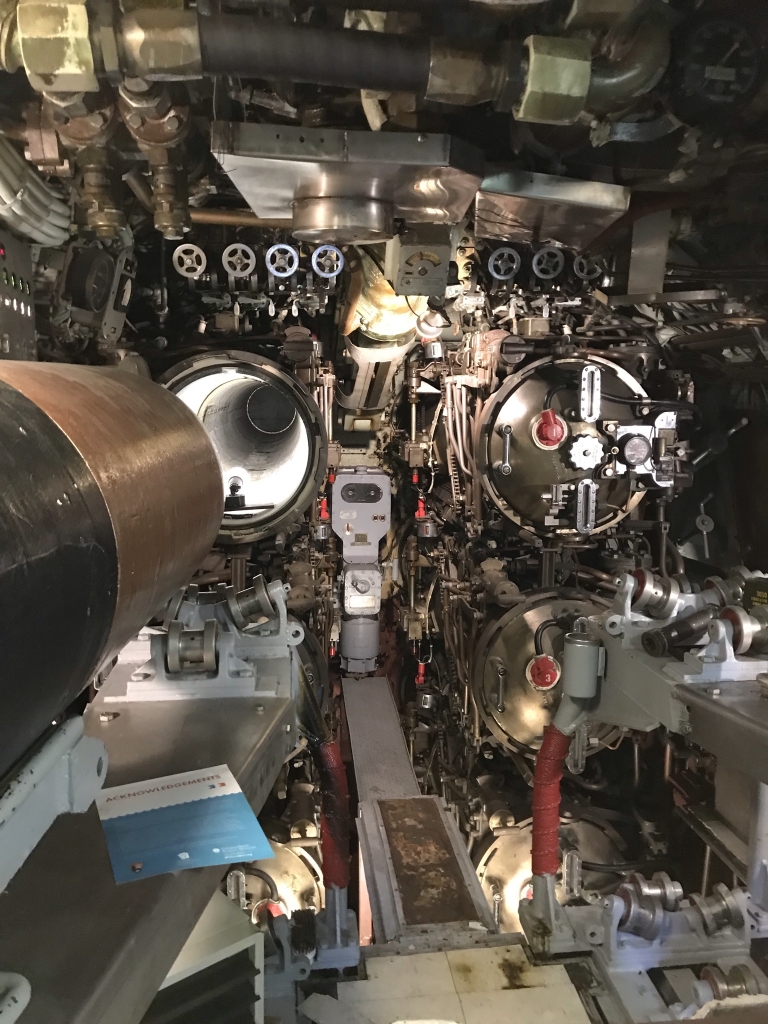
This is one of the torpedo rooms, I forget if it was fore or aft. What you can't see in this photo is the folded-up bunks on the walls on the sides. Yes, sailors actually slept in here too, because they wanted to use as much space as possible to get as many sailors as possible living and working in this cramped metal tube.
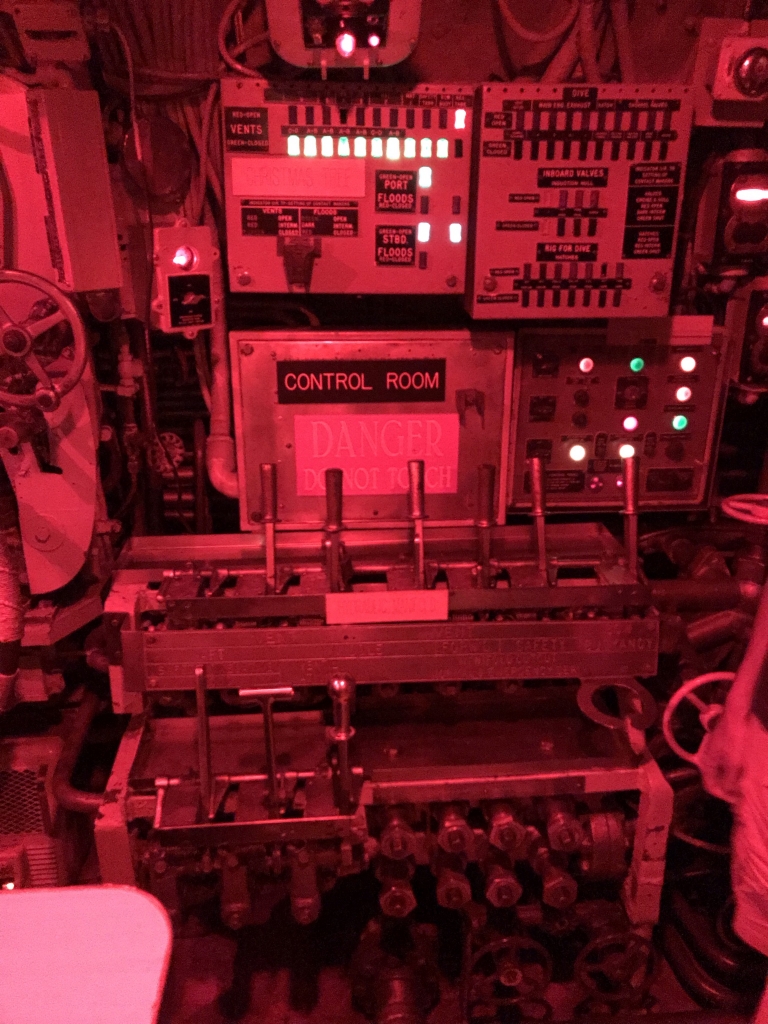
This entire room was bathed in a dim red light. It seems that at night, this kind of dim red light was the only light on the ship. This was so that if anyone had to go up top and make any observations, their eyes wouldn't have to adjust to the darkness outside.
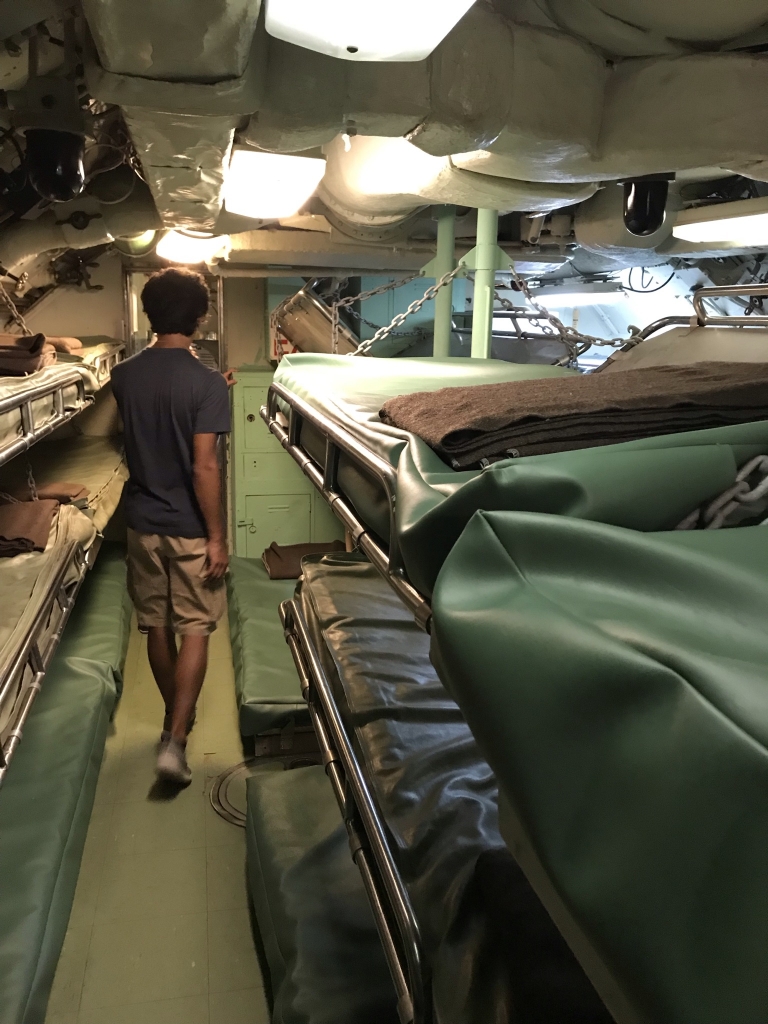
Enlisted sailors' bunks. The tour guide said we could lie down on any of these. I declined because I was drenched with sweat which I didn't want to get all over any of the bunks, but he rightly pointed out that wasn't an issue for the sailors serving on this ship during the war. They were all probably also sweaty.
After taking in all the history from the two museum ships, I set off to find my hostel and check in. Apple Hostel wasn't too far from the waterfront, being on Bank Street (which is really more of an alley than a street) which intersects with Chestnut and Market Streets, paralleling 2nd and 3rd Streets. The hostel actually occupies two separate buildings on opposite sides of the narrow street, and my dorm was in the one across the street from the building with the lobby. This place has the distinction of being the first hostel I stayed at on this side of the world, and I'd say it's comparable to the better ones I've stayed at in Europe.
It was getting late and there were no more museums and such to walk through that day, so there was one more thing I wanted to take a look at before the night fell, something I'd seen on Atlas Obscura: the giant organ in the Wanamaker Building. This was one of America's first department stores, having opened back in 1876, and today is a Macy's. It's most famous for housing the world's largest pipe organ, which is what I wanted to see.
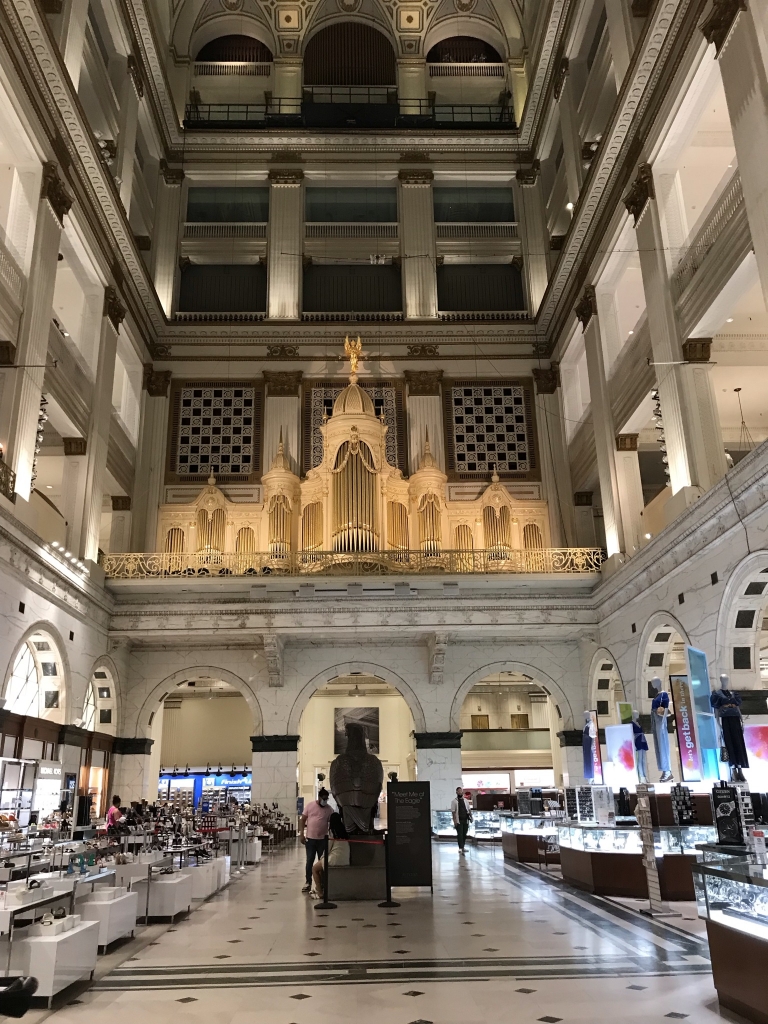
Here's the organ. And guess what I just found out, those decorative pipes that stand out in the center of this photo aren't even the real pipes! Look closely at the archways at the top, you can see the real pipes hiding back there.
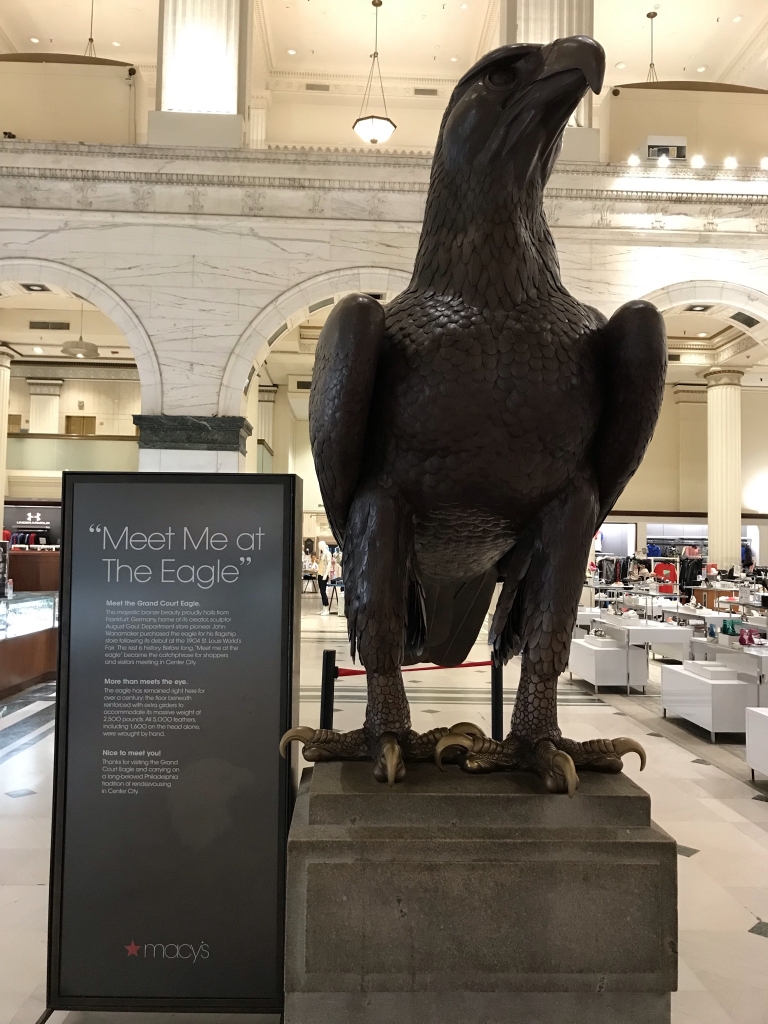
This eagle statue is another famous part of Wanamaker's.
Even though I'd walked all the way to the store from the hostel, I didn't feel like doing it again so I took a bus back.
By the time I usually eat dinner, I just wasn't all that hungry. That cheesesteak I had for lunch was really filling, so all I had for "dinner" was a big mixed fruit bowl from 7-11. Back at the hostel I took a shower and changed clothes, since it had been so hot out that day and I had sweated a lot.
The sun was going down and I wanted to do some bar hopping. Looking back I think I should have gone to South Philly because Passyunk Ave. was the perfect place to do that. But I didn't venture too far from the hostel, staying in the Old City area. The first bar, I don't remember the name of, but it was on Chestnut Street. I had an Ommegang Witte there; not exactly local, it's made in upstate New York, but still worth it.
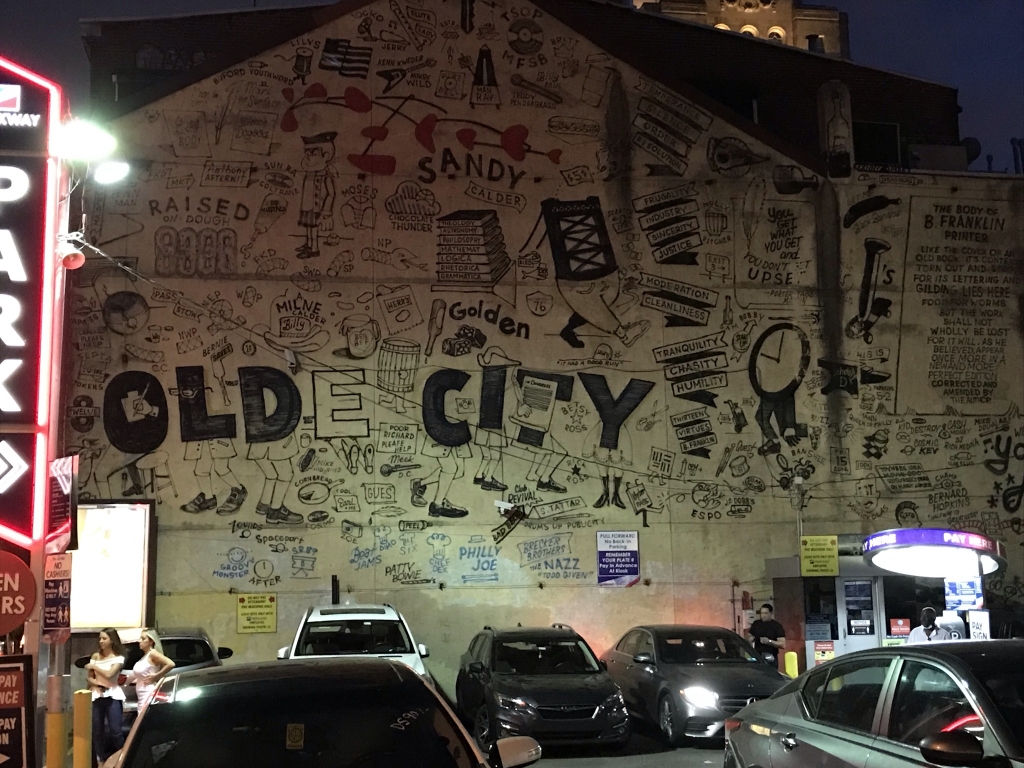
The second bar I stopped in was the last of the night, called Rotten Ralph. The first beer I had here was a Rolling Rock. This is the kind of beer I call a legacy beer; a local brew that's not a craft brew but one that's been around for over a century and can be bought for cheap in corner stores. Rolling Rock is made in Latrobe, Pennsylvania. I hadn't drunk one in many years and since I'd exponentially increased my beer-tasting experience since then, I wanted to drink another one and judge how it tasted now. And it's really not impressive. There's something about its flavor that--I know this is going to sound really bizarre--vaguely reminds me of processed cheese. That's what I thought the last time I had one, and I still got this impression now. If you want a legacy beer from Pennsylvania that tastes good, get a Yuengling.
Not feeling like walking around much more, I stayed in Rotten Ralph for a Kona Big Wave and two Miller Lites and then called it a night.
